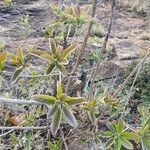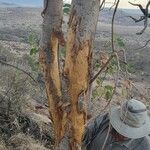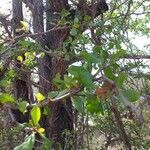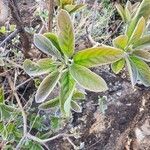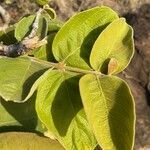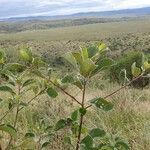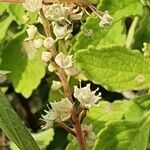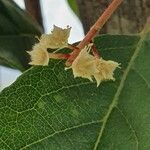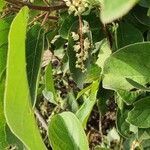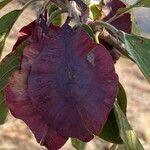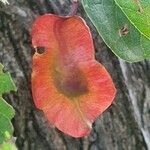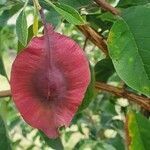Shrub or small tree 7–15 m. high; bark grey, fissured; long shoots usually straight; lateral shoots ending in spur shoots, rarely with additional lateral spur shoots; spines occasionally present and only on the long shoots.. Leaves borne in fascicles on the spur shoots; lamina chartaceous, broadly obovate to elliptic-obovate, up to 7.5 cm. long and 3 cm. wide, apex rounded, emarginate or mucronate, base obtuse to cuneate, usually densely pubescent when young, becoming glabrescent; lateral nerves 3–5 pairs, ± impressed above; petiole0.5–1.5(–2.5) cm. long.. Inflorescences of lateral spikes 5–8 cm. long; peduncle 1.7–2 cm. long, densely to sparsely pubescent.. Flowers cream or white, glabrous or nearly so.. Fruit (fig. 12/3, p. 79) purplish brown or red, elliptic-oblong in outline, 4–6.5 cm. long, 2–3 cm. wide, apex obtuse, deeply emarginate or mucronate; stipe up to 7 mm. long.. Cotyledons 2, with petioles 3–4 mm. long, borne above soil-level.
A bushy shrub and also a medium sized tree. It grows 5-15 m tall. It can have a girth of 1.5 m. It can have one or many stems. The bark is light grey and ribbed along its length. The branches hang over. The short twigs point upwards and at right angles to the branches. The leaves and flowers are crowded at the ends of the small branches. The bark on the twigs strips off in short lengths. The leaves are small. They are 1.3-5 cm long by 2.5 cm across. They are oval and often widest in the upper half and taper to the base. The leaves are dark green on the upper surface and lighter green and hairy underneath. The flowers are small and starry. They are white with a puff of yellow stamens. They are in lax spikes at the ends of short branches. They have a strong scent. The fruit are 3.5-5 cm long and oval. The seed in the thickened centre is surrounded by a tough flat wing. They turn deep wine red when ripe.
Small deciduous tree 7–15 m. high or shrub; crown narrow-ovoid to rounded; bark pale-grey to grey-black, deeply fissured; long shoots usually straight; lateral shoots ending in spur shoots, rarely with additional lateral spur shoots; spur shoots rarely borne directly on the long shoots; spines occasionally present but only on the long shoots.
Leaves in fascicles on spurs, petiolate; lamina up to 7·5 x3 cm., chartaceous, broadly obovate to elliptic-obovate, usually densely pubescent when young, ± glabrescent, apex rounded or emarginate or mucronate, base obtuse to cuneate; lateral nerves 3–5 pairs, ± impressed above; petiole 0·5–1·5(2·5) cm. long.
Small deciduous tree or shrub, 7-15 m high. Spines occasionally present but only on long shoots; long shoots usually straight. Leaves in fascicles on short spur shoots, lateral nerves impressed above. Fruit 40-65 mm long. Flowers cream or white.
Fruit purplish-brown or red, 4–6·5 x 2–3(5) cm., elliptic-oblong in outline, apex obtuse, deeply emarginate or mucronate: stipe up to 7 mm. long.
Cotyledons 2, 10–11 x 18–20 mm., transversely elliptic to subreniform with petioles 3–4 mm. long, borne above soil level.
Inflorescences of lateral spikes 5–8 cm. long; peduncle 1·7–2 cm. long, densely to sparsely pubescent.
Flowers cream or white, glabrous or nearly so.
Stamens 3–4 mm. long; anthers 0·5 mm. long.
Sepals triangular.
Disk pilose.
